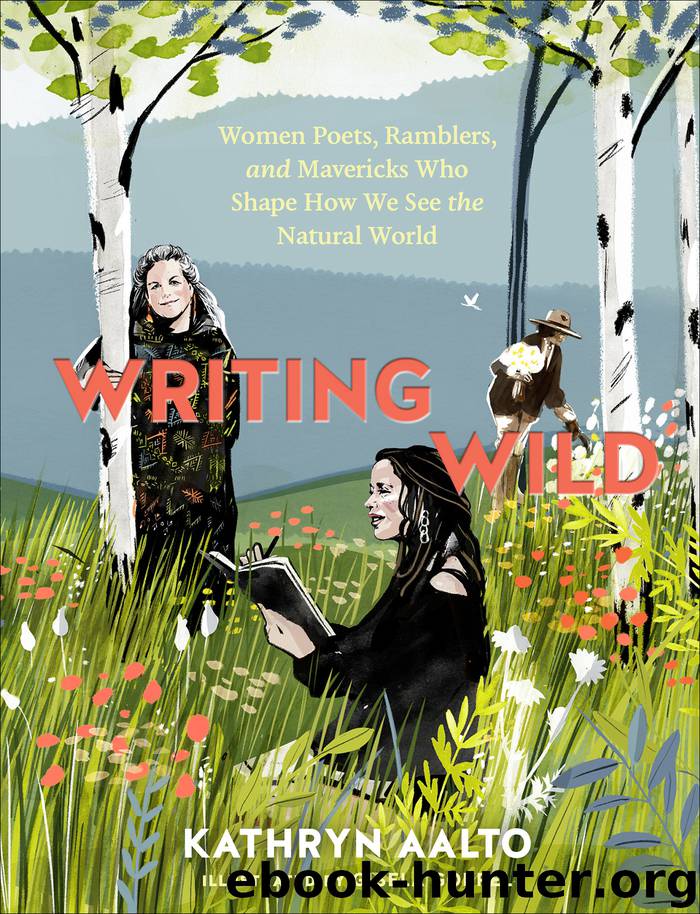Writing Wild by Kathryn Aalto

Author:Kathryn Aalto
Language: eng
Format: epub
Publisher: Timber Press
Published: 2020-06-15T00:00:00+00:00
Lauret Savoy
Trace
NOUN. A way or path.
A course of action.
Footprint or track.
Vestige of a former presence.
An impression.
Minute amount.
A life mark.
VERB. To make one’s way.
To pace or step.
To travel through.
To discern.
To mark or draw.
To follow tracks or footprints.
To pursue, to discover.
Trace: Memory, History, Race, and the American Landscape
I know someday soon I’ll take a walk with Lauret Savoy. I’d like it to be a long walk to hear all she has to say. It could be crunching along a trail near her home in the leafy hills of western Massachusetts. It could be the streets in Los Angeles or Washington, DC, where she lived as a child. It could be a plantation in South Carolina. It could be the US–Mexico border. Wherever it is, I know what I’ll do: listen.
Until that time, we settle for a phone conversation. I quickly discover her gentle way of speaking in poetry. She tells me, “By the age of five, I believed I was a child born of sun-lit Earth and deep blue sky. When I looked at my skin, I saw the color of dry land in Southern California and the Southwest. And when I looked at my veins, it seemed that sky flowed in them. I believed I was made of sky and of land. That was what anchored the child-me.”
You can understand why I want more opportunity to listen.
She tells me, “By 1968, my family had moved from California to Washington, DC, and we arrived in time to experience the riots. That was when I, as a small child, learned about racism. I was spat upon and I was hated. I needed to learn who I was then. That initial learning began in a struggle to answer or come to terms with questions that started to haunt me about origins: about who I was and who we were and what the American land was.
“That led me to try to trace not just my familial past but our nation’s history: how the past and present have marked me and marked American society and marked the land. That led me to ask how geology and history and memory are related. The past that I come from and where we all come from is not so unlike the fragmented pieces of Earth history. But in the human past, the gaps are left by generations of silences, by losses of language and voice, and by displacement that involved movement on the land by choice as well as by force; it also involved forced servitude. When you think about history, gaps come from complex dimensions of lives flattened over time under the weight of ignorance and stereotype. What remains are dismembered narratives about who we are to each other and to this land. And what I needed to do was engage, interrogate, encounter, and understand the nature of the silences and the nature of what is known as well as unknown.
“I have been drawn to studying fragments—rocks, sand, the dust of lives—and trying to understand how they can be fitted together.
Download
This site does not store any files on its server. We only index and link to content provided by other sites. Please contact the content providers to delete copyright contents if any and email us, we'll remove relevant links or contents immediately.
| Books & Reading | Comparative Literature |
| Criticism & Theory | Genres & Styles |
| Movements & Periods | Reference |
| Regional & Cultural | Women Authors |
4 3 2 1: A Novel by Paul Auster(11087)
The handmaid's tale by Margaret Atwood(6887)
Giovanni's Room by James Baldwin(5910)
Big Magic: Creative Living Beyond Fear by Elizabeth Gilbert(4745)
Asking the Right Questions: A Guide to Critical Thinking by M. Neil Browne & Stuart M. Keeley(4612)
On Writing A Memoir of the Craft by Stephen King(4233)
Ego Is the Enemy by Ryan Holiday(4013)
Ken Follett - World without end by Ken Follett(3985)
The Body: A Guide for Occupants by Bill Bryson(3843)
Bluets by Maggie Nelson(3736)
Adulting by Kelly Williams Brown(3691)
Guilty Pleasures by Laurell K Hamilton(3607)
Eat That Frog! by Brian Tracy(3538)
White Noise - A Novel by Don DeLillo(3447)
The Poetry of Pablo Neruda by Pablo Neruda(3380)
Alive: The Story of the Andes Survivors by Piers Paul Read(3327)
The Book of Joy by Dalai Lama(3245)
The Bookshop by Penelope Fitzgerald(3242)
Fingerprints of the Gods by Graham Hancock(3233)
